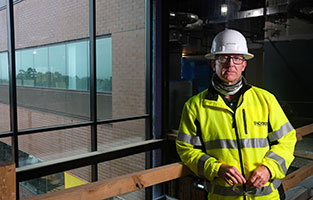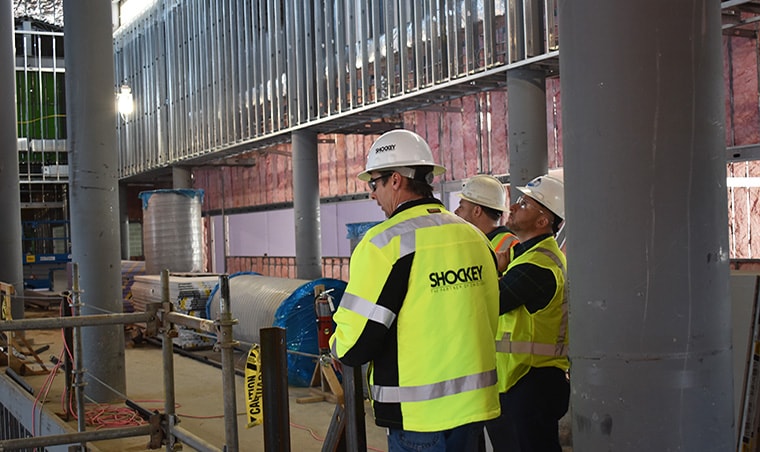When the COVID-19 outbreak began in March, projects at Howard Shockey & Sons, a Winchester-based commercial construction company, kept moving forward. After all, construction is considered an essential business, and unlike some other states, Virginia did not restrict construction activity at the start of the pandemic.
While Shockey’s work continued, albeit with some hiccups due to the pandemic, the 124-year-old company has an uncertain outlook on its business performance in the next year.
Some of its planned projects are delayed because of economic uncertainty created by COVID-19, and the company is bracing for revenue losses in 2021.
“The unpredictability of it makes it harder to do revenue projections and manpower projections,” says Shockey President Jeff Boehm. “Neither the public sector nor the private sector is sure what’s coming next.”

Jeff Boehm, president of commercial construction firm Howard Shockey & Sons, Inc. [Photo by Norm Shafer for Virginia Business]
The economic crisis caused by the coronavirus pandemic is leading to uncertainty about how much work the construction industry will see in 2021.
Shockey’s outlook is a microcosm of the construction industry in Virginia and in the country.
National Construction Trends
Nationally, construction output dropped significantly in the second quarter of 2020, while industry leaders’ confidence in sales, staffing, and profit margins also declined in July, according to reports by Associated Builders and Contractors, a national trade organization. During the next six months, less than 29% of contractors expect their profit margins to increase, while more than 47% expect declining profit margins, according to the organization.
By July, the construction industry had recovered about 56% of the 975,000 jobs it had lost during March and April, according to ABC stats. But as companies adjust their spending plans and pull back on capital expenses to make up for recent losses, construction companies will begin to see the impact of these reduced and lost construction starts in 2021 and 2022, according to construction economic analyst Ed Zarenski’s Construction Analytics blog.
“While many contractors will continue to work through backlogs for the balance of 2020, it may be difficult to secure work for 2021 as fewer projects are bid out and project starts become increasingly rare,” Anirban Basu, ABC’s chief economist, said in a statement.
In Virginia, certain kinds of projects — such as new hotels, office buildings, and retail construction — are on hold or nonexistent, says Patrick Dean, president of Associated Builders and Contractors of Virginia. Along with COVID-19, there is uncertainty related to the upcoming presidential election and government spending for 2021, Dean says.
Doubt among developers, caused by an uncertain COVID-19 economy, is the biggest challenge for Shockey, Boehm says. The company is moving forward with some public sector jobs, such as two new elementary schools on which it recently broke ground in Loudoun County. But many of Shockey’s projects for the private sector, of various types, are on hold indefinitely.
“In each case, the project is not canceled,” Boehm says. “They want to build but not start quite yet. All have uncertainty about whether COVID-19 will allow the level of demand for their services that they can count on in their pro forma.”
The situation is similar for Barton Malow, a Michigan-based firm with locations in Richmond and Charlottesville. Some of the company’s largest clients in Virginia are universities. But since the pandemic began, new construction jobs have slowed in higher education, says Dan Buchta, vice president of Virginia operations for Barton Malow.
“The higher education clients have definitely tapped the brakes in rolling out more RFPs, trying to get certainty on their revenue streams and classes,” he says. “We are still waiting to see.”
Even so, some projects that the company started in Virginia before COVID-19 remain on track. To be sure, those include student health and wellness centers at two universities — the University of Virginia and the University of Richmond.
“It’s new project starts and new work acquisitions that have been more challenging,” Buchta says.
Supply chain slowdown
Finding and obtaining necessary construction materials in a timely manner during a pandemic has made it difficult for some businesses to keep projects on track.
Right now, it takes about twice as long to obtain certain supplies, compared with before COVID-19, says David Yergin-Doniger, president of WG Construction Co. Inc., a Manassas-based firm that specializes in major road construction, including work to widen Interstate 66.
In April, as some manufacturers shut down for a time and various states limited interstate travel because of the pandemic, obtaining materials was nearly impossible.
Additionally, positive COVID-19 cases among concrete-truck drivers and other construction crews affected supply routes, Yergin-Doniger says.
Some supply issues have improved since the spring, but delays in obtaining some materials, particularly overseas shipments, remain.
“The best thing we can do is get all of the materials to the jobs before we get there,” Yergin-Doniger says.
Similarly, to avoid delays, there is a requirement that all materials are pre-purchased and stored ahead of time for a fast-track renovation project next summer for Clancy & Theys Construction Co., says Bill Goggins, vice president and CEO of the firm’s Virginia division in Newport News.
In particular, Pennsylvania’s lockdown in the spring caused delays for manufacturers who work with Clancy & Theys.
“It’s not the way it was before,” Goggins says. “Every day, multiple times a day, we have to think about the impacts of the virus and what it’s going to do to us. We are certainly not back to normal.”
Safe job sites
Like businesses throughout the country, construction companies have had to step up and change safety measures at job sites and in offices to keep employees safe and to mitigate the spread of the coronavirus.
For WG Construction, this includes daily, mandatory temperature checks for employees, face coverings and paperless timesheets. Employees also carry their own pens for signing paperwork.
People working on job sites for Clancy & Theys now sit in their trucks and use their phones and iPads for remote meetings rather than gathering in an enclosed trailer, Goggins says.
“We will err on the side of safety,” says Goggins, whose Raleigh, North Carolina-based company employs about 100 people in Virginia.
In the past few months, several employees at WG Construction were suspected of having COVID-19, and crew members who had contact with those employees quarantined for 14 days, says Yergin-Doniger. With the manpower interruption, it wasn’t easy to keep some jobs on schedule, he adds.
“If a key person gets sick, that is very concerning,” he says. “It’s like a domino effect.”
Dean of ABC Virginia says he has been impressed with the safety measures that companies in the state have put in place at job sites.
“I have been on 35 job sites in the past month [July through August],” he says. “I am seeing wash stations, and masks are everywhere. Everybody wants their employees to go home safe every day. There is a balancing act between ‘we want to be safe’ and ‘we need to continue to build the project and complete the job.’”
Even so, keeping a consistent work crew is a challenge during the pandemic. Across the state, Dean says, contractor productivity is down about 20%. “You’ve got some individual challenges,” he says. “Quite often crews aren’t 100% manned. One day a job gets shut down and 40 electricians get quarantined. Overall, everyone’s suffered somewhat.”
Shockey also has seen significant fluctuations in manpower during the pandemic. At the beginning of the virus outbreak, some employees didn’t want to work because they were nervous about potential exposure to COVID-19, Boehm says.
Some of these challenges continue.
“In our industry, COVID-19 hasn’t stopped,” Boehm says. “We are still dealing with illness and quarantine and all of those things. It’s become a more routine part of what we do, but it hasn’t gone away.”
To be sure, not all construction projects have been significantly impacted by COVID-19. For WG Construction, the Interstate 66 widening project continues, along with the demand for data center construction in Northern Virginia.
“The path to those projects being built was in place for the past couple of years,” Yergin-Doniger says. “Public work never stopped.”
But how will public projects look in the next 12 months? Yergin-Doniger says he tracks economic indicators regularly and in particular Virginia’s unemployment numbers, with more than 265,000 Virginians still out of work as of late August.
“There are a lot of signs that the economy is about to take a major nosedive,” he says.
Dean expects demand for health care projects to remain high and he believes that some building activity could shift to interior renovations for office buildings, which may be reconfigured because more people are working remotely.
“Until we get a vaccine that works, I think we are in a challenging [environment] for a while,” Dean says. “But there are opportunities.”
This article appeared in the October 2020 issue of Virginia Business. See the entire story here, by Jenny Kincaid Boone.

